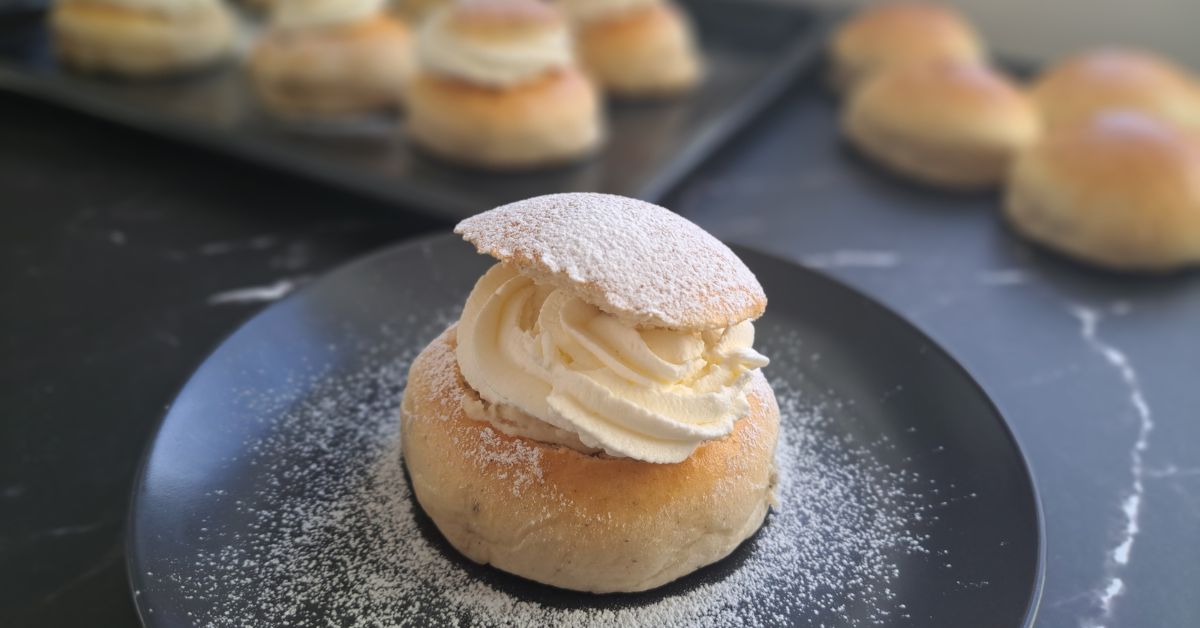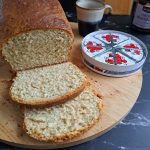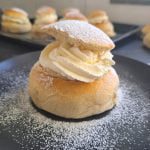Semla recipe

Semla/Semlor are Swedish words that refer to a traditional pastry, particularly popular during the Lenten season in Scandinavian countries, especially Sweden. Semlor is the plural form of semla, denoting multiple pastries. Semla holds a special place in the hearts of Swedes, particularly during the celebration of Fat Tuesday, known as “Fettisdagen” in Swedish. Traditionally, Fat Tuesday marks the last day of indulgence before the solemn period of Lent, a time of fasting and reflection leading up to Easter.
During the Middle Ages, fasting was a common practice in Christian Europe, and people abstained from certain foods, including dairy and eggs, during Lent. During the pre-Lenten period, particularly on Shrove Tuesday (known as Fat Tuesday), people ate Semlor. This day marks the beginning of Lent. On this day, people would consume richer foods before the fasting period.
Over time, the tradition of eating semlor during Lent transformed. By the 18th century, the plain buns began to be filled with almond paste and whipped cream. This added richness to the pastry, making it a more luxurious treat and became popular in the 19th and 20th centuries. During the winter and early spring in Sweden, people now widely enjoy semlor instead of being mainly associated with Lent and Shrove Tuesday. Bakeries and cafes start offering semlor in early January, and the season lasts until Easter.
I cut off the top of the cardamom-spiced wheat bun and filled it with a generous layer of almond paste and a dollop of whipped cream. I replaced the top as a hat for the pastry and dusted it with powdered sugar.
Almond paste
There are different ways to prepare the almond paste. Some use store-bought almond paste or marzipan. I have tried semlor with both store-bought and homemade almond paste. We prefer making homemade almond paste using ground almonds, powdered sugar, and water. Making almond paste at home allows you to have control over the ingredients and customize the sweetness level according to your taste.


Semla Recipe
Ingredients
1 cup = 250ml
Pre-dough (starter) for the buns
- 1 cup warm milk 220ml
- 2 tsp yeast
- 1 tbsp sugar
- 1 ⅓ cups or 150 grams all-purpose flour
Dough
- 2 cups or 230 grams of all-purpose flour
- 7 tablespoons or 100 grams of salted butter
- ⅔ cup or 50 grams of powdered sugar
- 2 tsp ground cardamom
- 1 room-temperature egg
Egg wash
- 1 egg
- 1 tbsp water
Almond filling
- 1 ½ cups or 200 grams of ground almonds
- 8-10 tbsp powdered sugar adjust to your preference
- 8-10 tablespoons of water or milk
- 2 drops of almond extract
To Top
- 1 ½ cups whipping cream
- 4 tbsp powdered sugar
Instructions
Pre-dough preparation
- In a stand-mixer bowl, add in the lukewarm milk (around 37 degrees), 1 tbsp sugar, 2 tsp active dry yeast and dissolve. Add the flour to the yeast mixture and mix until a sticky dough forms.
- Cover the bowl with a cloth and let it sit for about 20-30 minutes or until frothy.
Dough preparation
- Add the room-temperature butter, egg, flour and ground cardamom to the pre-dough mixture. If you are using unsalted butter, add 1 tsp salt as well and knead the dough in a stand mixer for about 10 minutes until smooth and elastic.
- Divide the dough into equal portions, and roll each portion into a ball, each weighing around 75 grams. and place them on a baking sheet lined with parchment paper. If you prefer your buns smaller reduce it to 60 grams.
- Sprinkle some dry all-purpose flour over the buns, cover it with a tea towel and allow it to rise for another 1-2 hours.
- After the buns are doubled in size, brush the buns with a beaten egg mixed with a tablespoon of water.
- Bake in a preheated oven for 12 -15 minutes at 200 degrees Celsius or until the buns are golden brown.
- Allow the buns to cool completely on a wire rack.
Almond paste
- There are different ways to prepare this almond paste. I used 200 grams of ground almond, powdered sugar, water and almond extract. Some use egg white as a binder, whereas I prefer to add water as a binding agent.
- Blend them in a blender or a food processor to a slightly coarser paste or a fine paste.
Almond filling from the whole almonds
- If you are using the whole almonds to form a paste, roast them in a preheated oven at 180 degrees for 10-12 minutes or until they become fragrant and slightly golden. Keep an eye on them to prevent burning. Allow the roasted almonds to cool completely.
Blanching
- Blanching is a common method to remove the skins from almonds before roasting, and it can contribute to a smoother texture in the final almond paste.
- Place the whole almonds in a heatproof bowl.
- Pour boiling water over the almonds, ensuring they are fully submerged.
- Let them soak for 1-2 minutes, then drain and rinse with cold water.
- Pat the almonds dry with a clean kitchen towel.
- Pinch each almond to slip off the skins. The blanched almonds should have a smooth surface.
- In a food processor, grind the blanched almonds until finely powdered.
- Add the powdered sugar to the ground almonds and pulse to combine.
- Gradually add water while processing until the mixture comes together into a cohesive paste.
- If the paste seems too dry, you can add a little more water, one tablespoon at a time.
- Continue processing until the almond paste reaches your desired consistency – smooth or slightly coarse.
Whipped cream
- Whip the heavy cream with powdered sugar in a bowl with an electric mixer or a stand mixer with the whisk attachment until stiff peaks form.
Assembly
- Slice off the top of each bun or cut the triangular lids of the buns with the help of scissors or a sharp knife.
- Scoop out some of the centre to create a well.
- Fill each bun with the almond mixture.
- Pipe or spoon whipped cream on top of the almond filling.
- Place the tops back on the buns.
- Dust with powdered sugar and serve immediately.
- Enjoy your homemade semlor!
Notes

1 thought on “Semla recipe”